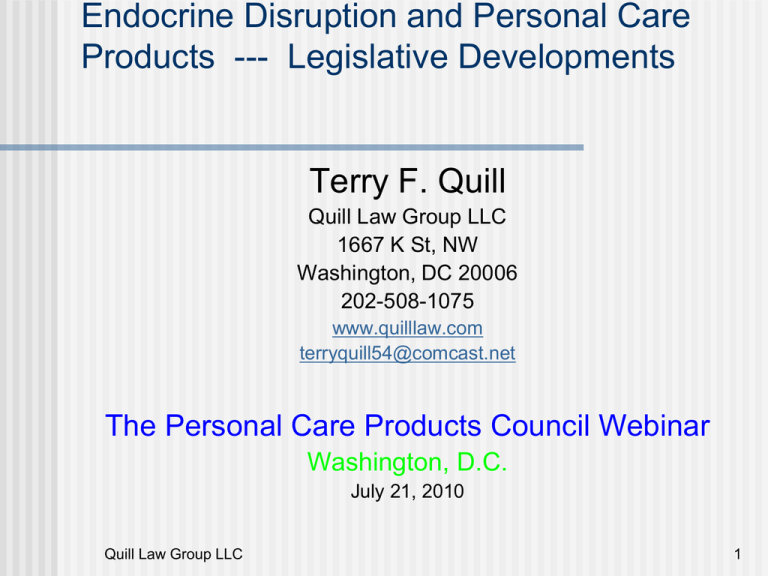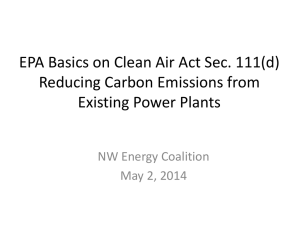
Endocrine Disruption and Personal Care
Products --- Legislative Developments
Terry F. Quill
Quill Law Group LLC
1667 K St, NW
Washington, DC 20006
202-508-1075
www.quilllaw.com
terryquill54@comcast.net
The Personal Care Products Council Webinar
Washington, D.C.
July 21, 2010
Quill Law Group LLC
1
Topics
History Relevant to Personal Care Products
Driving “Science” in 1996
FQPA of 1996
SDWA Amendments of 1996
EPA’s Development and Implementation of its EDSP
New “Scientific” Claims
Recent Legislation
EPA 2010 Appropriations HR 2996
Amendments to SDWA (AQUA) HR 5320
Quill Law Group LLC
2
Endocrine Disruption in 1996
Some Perspective on the Science
Concern based on claimed endocrine related
effects/trends observed in wildlife and humans.
E.g., decreased sperm counts; increased breast cancer
rates; neurological effects (ADD); effects in male fish;
alligator penis size; and many others.
The “top down” approach
“Our Stolen Future”
Tulane study (Additive effects)
Belief that assays were readily available
E-Screen ($50/chem)
Quill Law Group LLC
3
Endocrine Disruption in 1996
The Congressional Reaction
Passage of the Food Quality Protection Act
EPA shall “develop a screening program, using
appropriate validated test systems and other
scientifically relevant information, to determine
whether certain substances may have an effect in
humans that is similar to an effect produced by a
naturally occurring estrogen, or such other
endocrine effect as the Administrator may
designate.”
EPA shall issue test orders.
Quill Law Group LLC
4
FQPA Continued --Substances
In carrying out the screening program the
Administrator
(A) shall provide for the testing of all pesticide
chemicals; and
(B) may provide for the testing of any other
substance that may have an effect that is
cumulative to an effect of a pesticide chemical if
the Administrator determines that a substantial
population may be exposed to such substance.
Quill Law Group LLC
5
Endocrine Disruption in 1996
Congressional Reaction
Passage of Amendments to the Safe Drinking
Water Act
In addition to the substances referred to in [the FQPA] the
Administrator may provide for testing under the screening
program authorized by [the FQPA], in accordance with
the provisions of [the FQPA], of any other substance that
may be found in sources of drinking water if the
Administrator determines that a substantial population
may be exposed to such substance.
Quill Law Group LLC
6
EPA’s Response (1996-2010)
Develop and Implement the EDSP
Two Tiered Screening and Testing Program
• T1S – Determine whether a substance has the
potential to interact with the endocrine system.
• T2T – Determine adverse effects and dose-response.
Endocrine, Androgen and Thyroid
Humans and Wildlife
Phased approach
• Per SAB/SAP and OMB
• 67 “pesticide chemicals” in initial phase
• Orders have been issued
Quill Law Group LLC
7
Develop and Implement the EDSP
Concerns
Validate the Tier 1 screens
• Is the Tier I battery validated?
• Are the Tier 1 assays fully validated?
• Validating on the backs of initial order recipients?
Guideline and protocol problems for T1S assays
• Can the screening assays be conducted pursuant to EPA’s
proscribed guidelines and protocols.
Assess Tier 1 Results and revise the Tier 1 assays
and battery
• Develop criteria for assessing Tier 1 Results
• Use a weight-of-evidence approach
Quill Law Group LLC
8
Develop and Implement the EDSP
Concerns - Continued
EPA needs to develop criteria for triggering T2T
EPA still needs to develop and validate T2T
Use Other Scientifically Relevant Information
EPA needs to develop criteria
Functionally equivalent data
Data sufficient for managing risks
Cost
• T1S: $1 million (+)/substance ?
• T2T: $3 million (+)/substance?
Quill Law Group LLC
9
New “Scientific” Trends
ED Advocates focusing on mechanism of
action rather than adverse effects
Changing Definition of ED
• Why isn’t an endocrine interaction necessarily
indicative of an adverse effect?
Using biochemical observations and mechanistic
arguments to promoting theories and
hypotheses rather than relying on evidence of
effects
• “Bottom up approach”
Use of the precautionary principle
Quill Law Group LLC
10
New Trends --
Continued
The low-dose hypothesis (not a new trend)
The Endocrine Society Scientific
Statement
Mechanism + Precautionary Principle
Selective review of the science
More funding for research (mostly
mechanistic)
More theories and hypotheses?
Quill Law Group LLC
11
New Trends
-- Continued
Push for more and quicker testing
Congress, EPA and Public
More public access to assay results
More consideration of evidence of
endocrine effects in selecting chemicals
Focus on drinking water contaminants
Quill Law Group LLC
12
Potential Effects on Business
Unjustified Product De-selection due to:
Intentional and unintentional result of
improper communication of assay results and
risks
• Exacerbated by dissemination of testing results
and lack of WOE assessment tool
Lack of assay specificity
• Exacerbated by rush to test
New definition of ED and use of the
Precautionary Principle
Quill Law Group LLC
13
Potential Effects on Business
Regulatory effects
Will we eventually regulate based on mechanism or
molecular events rather than adverse effects?
Penalties for failure to test
Cost of Screening and Testing
Exacerbated by rush to test
Exacerbated by lack of a WOE assessment
procedure
Exacerbated by failure to consider OSRI
Quill Law Group LLC
14
Potential Effects on Business
Competition from claimed “green chemistry”
Some new products may be riskier or untested
“Natural” is not always safer or as effective
May provide problems and opportunities
Litigation risks
Product injury claims?
Environmental damages?
Quill Law Group LLC
15
HR 2996 -- EPA 2010 Appropriations
Rep. Moran, June 2009
Requirements
Publish within one year of enactment a second list of no less than 100
chemicals for screening that includes drinking water contaminants,
such as halogenated organic chemicals, dioxins, flame retardants
(PBDEs, PCBs, PFCs), plastics (BPA), pharmaceuticals and personal
care products, and issue 25 orders per year for the testing of these
chemicals. This process also should allow for public input.
EPA is expected to publish the list, revised policies and
procedures and Information Collection Request in next 2-4
weeks
Opportunity to comment
May see pharmaceuticals and ingredients in personal care products on
list
Quill Law Group LLC
16
Assistance, Quality, and Affordability Act of
2010 (“AQUA”) HR 5320
Introduced by Rep. Markey and Moran on 5/5/10;
Adopted by Committee on 5/26/10.
Section 17 (endocrine provisions)
Amends SDWA to require EPA to list and require EDSP
testing of chemicals that may be found in drinking water
to which a substantial population may be exposed.
(Section 17)
Sets deadlines for listing and issuing orders.
New definition of “endocrine disruptor”
Quill Law Group LLC
17
AQUA --
Section 18
Continued
EPA shall carry out a study of Pharmaceuticals and
Personal Care Products in drinking water.
Status
Adopted by committee
Has not passed House
• May make it to the floor early this week
Senate version has no endocrine provision
• Work out in conference?
• Current SDWA gives EPA authority to require endocrine
testing of personal care product.
Quill Law Group LLC
18
AQUA
Provisions
Within 180 days of enactment EPA shall
develop and publish a publically searchable
database:
List Identified Substances
Provide status of testing
•
•
•
•
Orders
Deadlines
Data evaluation records
Whether action will be taken
Quill Law Group LLC
19
AQUA Provisions
-- Continued
Within 1 year of enactment EPA shall:
List at least 100 new substances
• 25 testing orders/yr for 4 years
• In addition to the 100 EPA is currently listing?
Plan for identification of additional substances
• Schedule test orders over 10 yrs.
Prioritize substances for listing
• Based on health threat as well as exposure
• Will this become a list of “Endocrine Disruptors”?
• Consider effects on sensitive sub populations
• Use “best available science”
Any person may submit a petition to add a substance to
the list
Quill Law Group LLC
20
AQUA Provisions
-- Continued
Within 2 years after enactment EPA must publish:
Guidance on updating protocols.
Procedures for triggering T2T
Procedures for considering OSRI
• Anyone can offer OSRI
• Will ED advocates want Tier 1 bypass based on their own
studies?
Quill Law Group LLC
21
AQUA Provisions
-- Continued
Revision of Testing Protocols
Within 2 years EPA shall determine whether science
warrants updating screening protocols.
Within 5 yrs and every 3 yrs thereafter determine
whether to revise screening protocols.
If protocols are revised EPA shall determine whether
substances already tested should be retested.
Testing protocols shall be designed based on “valid
scientific data”
• Verifiable measurements, small error rates, repeatable
results and control for confounders
Quill Law Group LLC
22
AQUA Provisions -- Continued
Results of testing
W/in 6 mos of receiving results of testing EPA must:
• Publish testing data
• Searchable “data evaluation records”
• Raw data?
• Take action
• Still Risk-based (see committee report)
• Publish determination concerning action
Assess results using “structured evaluation framework”
• Assess “weight of evidence” using “science based criteria”
• Evaluate endocrine mode of action and determine data
relevance, quality and reliability
Quill Law Group LLC
23
AQUA Provisions
-- Continued
Definition of Endocrine Disruptor
“An exogenous agent or mixture of agents that interferes or
alters the synthesis, secretion, transport, metabolism, binding
action, or elimination of hormones that are present in the body
and are responsible for homeostasis, growth, neurological
signaling, reproduction and development process, or any other
effect . . .”
Doesn’t this include almost any chemical, including food?
No mention of adverse effect.
Is anything positive in T1S an “endocrine disruptor”?
Will the definition lead to product deselection?
Quill Law Group LLC
24
Committee Report HR 5320
Section 18 - Endocrine disruptor screening
program
T1S identifies substances that may interact with the
endocrine system; interaction does not mean the
substance will cause an adverse effect
T2T determines adverse effects and dose-response
Regulatory decisions will continue to be based on
adverse effects using risk-based criteria
EPA to use best available science in prioritizing
substances for testing
Quill Law Group LLC
25
Committee Report -- Continued
EPA may allow for T1S bypass
• Seems to be at the Agency’s option
Acknowledges that EPA is currently looking
at 100 additional substances.
• Does this suggest that EPA must list another 100
substances under AQUA?
Quill Law Group LLC
26
Supporting Documentation
Copes of legislation, testimony and other
endocrine related materials may be found
at:
www.quilllaw.com
Quill Law Group LLC
27











